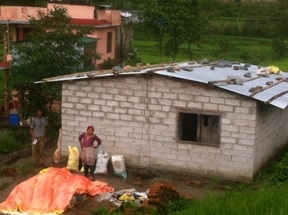Sanu Bajracharya, 48, of Shankharapur Municipality Kathmandu District is one of the several victims of April 25th earthquake. Just as to many others, the natural calamity took many things from him. He was a son of a farmer and holding that profession till now. After the devastating earthquakes, Bajracharya’s family sheltered inside the tarpaulin sheet for three weeks, later he found a room to rent. He shifted there with his wife, son and daughter-in-law. But after a month of living in a rented room, the house owner asked him to move to another house as they needed that for themselves.
Sanu Bajracharya, 48, of Shankharapur Municipality Kathmandu District is one of the several victims of April 25th earthquake. Just as to many others, the natural calamity took many things from him. He was a son of a farmer and holding that profession till now. After the devastating earthquakes, Bajracharya’s family sheltered inside the tarpaulin sheet for three weeks, later he found a room to rent. He shifted there with his wife, son and daughter-in-law. But after a month of living in a rented room, the house owner asked him to move to another house as they needed that for themselves.


Meanwhile, CIUD was coordinating with Ward Citizen Forum of Shankharapur Municipality-8, in selecting the earthquake affected families, under the selection criteria of UN-Habitat (People of Japan). After the verification by the community mobilizers, Bajracharya’s family was selected as one of the needy families by the forum and so, CIUD provided construction material to the family.
Bajracharya shared that he would not be able to build the shelter as per CIUD design (one room and one kitchen) because it would be small for his family. So, the technical staff of CIUD orientated him and the construction workers on how they could build a shelter with the cemented blocks he had and the construction material provided by CIUD in a safer and better way.
He became convinced with the engineer’s advice and started to build a shelter of 2 rooms and a kitchen with cemented blocks. He used CGIs and bamboos given by for roofing and completed shelter in 28 days with NRs 150,000, a loan from a co-operative.
The main reason he gave behind borrowing a loan and building the shelter was, “I won’t be able to clear the debris of my house soon and constructing the house as per the Govt. rules and regulations is quit impractical. So this shelter will be permanent home for me as long as I live”
This is an example of how people are going to reconstruction phase after the devastative earthquakes. The step that started from Bajracharya’s family certainly shows ‘a ray of hopes’ that the affected people at the community level have gained confidence in building their shelters in a safe and cost-effective way.
